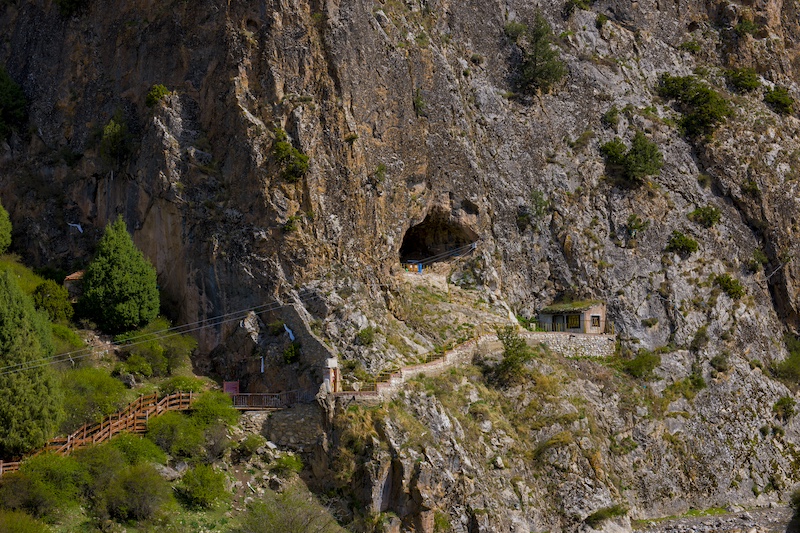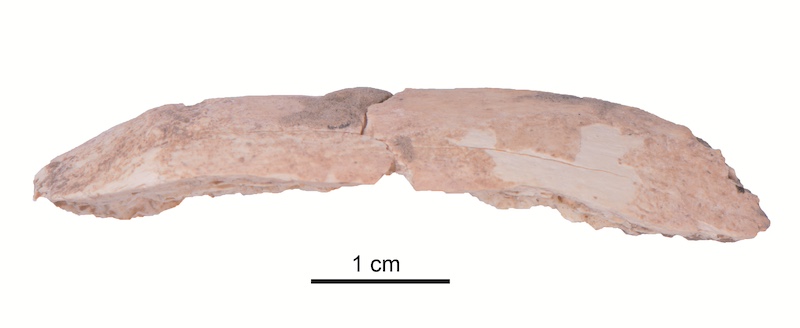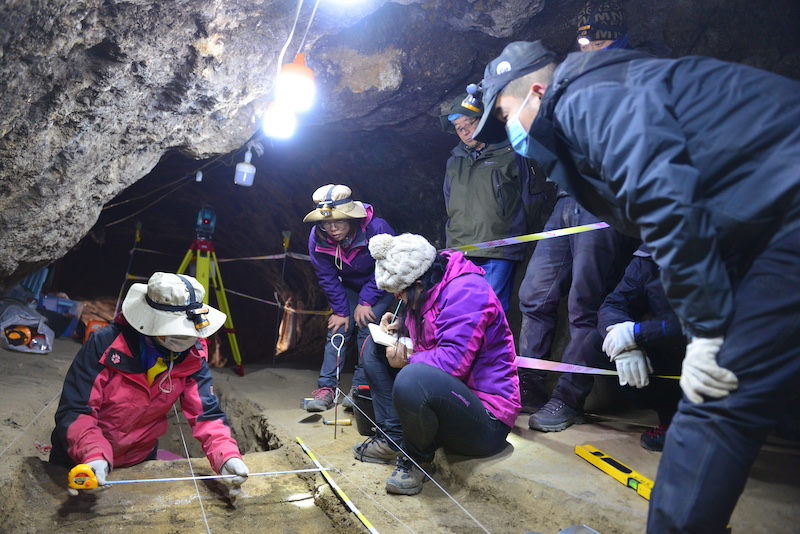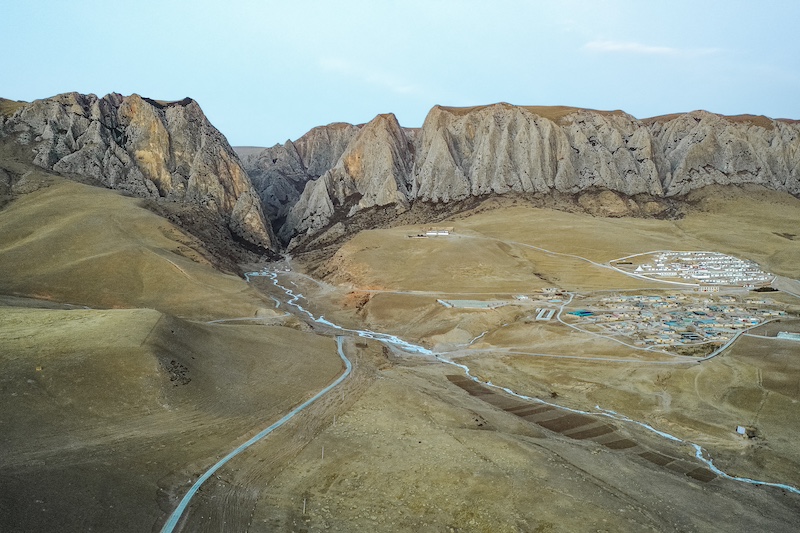This 2020 video from Ben G. Thomas on YouTube will introduce you to Denisovans, an extinct species of archaic humans that ranged across Asia some 285,000 to 25,000 years ago. The date of a new fossil shows Denisovans coexisted with modern humans on the Tibetan plateau. Curious about this artwork? See how scientists and artists created it, below.
A long-extinct species of humans, known as Denisovans, lived on the Tibetan plateau for over 100,000 years, overlapping with modern humans. The University of Reading said on July 3, 2024, that this finding is based on the study of fossils found in a cave on the Tibetan plateau, called Baishiya Karst Cave. The new work provides insights to the story of how and when Tibet was settled, the researchers said.
Researchers dated a rib bone found in the cave to an individual who lived about 40,000 years ago. That would make it the youngest Denisovan bone found so far and would mean the Denisovans coexisted with modern humans in what is now Tibet. Another site, some 800 miles (1,300 km) away on the Tibetan plateau, contains artifacts that reveal the characteristics of modern human craftsmanship and date to 40,000 to 30,000 years ago. As co-author Dongju Zhang of Lanzhou University in China told Science:
That means Denisovans survived until modern humans appeared in the region, which makes it possible [the two groups] had genetic communication.
The scientists published their peer-reviewed findings in the journal Nature on July 3, 2024.
Links between humans and Denisovans in Asia are not new. A 2018 study showed DNA matches between humans and Denisovans in parts of Asia. In particular, the 2018 study showed Denisovan DNA matches among Han Chinese, Chinese Dai, and Japanese. Prior to the 2018 study, it was known that the genomes of certain populations, such as indigenous peoples of Western New Guinea in Indonesia and Papua New Guinea, contained about 5% Denisovan ancestry.

Mysterious extinct humans, the Denisovans
Neanderthals were an extinct human species that once co-existed with modern humans (Homo sapiens). Another human species, not as well known, also existed around the same time. Scientists call them the Denisovans. These enigmatic ancient humans lived 285,000 to 25,000 years ago.
Denisovans got their name from the Denisova Cave in the Altai Mountains of Siberia, Russia, where scientists first found their fossils. The first identification of a Denisovan – from a young female finger bone – came in 2010. Then, in 2019, researchers reported a second discovery, this time in China. They had studied a lower jaw found in the Baishiya Karst Cave on the Tibetan Plateau, and it turned out to be Denisovan. That same cave subsequently yielded a second Denisovan fossil, a single rib bone, which researchers announced in 2024. And a 2022 paper revealed a third location: a tooth from a cave in Laos was Denisovan.
We don’t know a lot about Denisovans because their fossil record, which spans northern Russia to Southeast Asia, is sparse. Since there are so few fossils, it’s not possible to reconstruct their appearance based on a fossil skeleton. To identify Denisovan fossils, researchers use DNA or collagen protein analysis to show they were a human species distinct from Neanderthals and modern humans.
Making the portrait of the Denisovan girl
So there’s no way to know what the ancient Denisovan people really looked like. That’s because there isn’t a rich fossil record for Denisovans, as there is for Neanderthals. The Denisovans are known from only a few bone fragments. But, in 2019, scientists and artist Maayan Harel were able to reconstruct this portrait of an extinct Denisovan girl, thanks to DNA from the bone of her little finger.
A common ancestor
Neanderthals, Denisovans, and modern humans descended from a common ancestor known as Homo heidelbergensis. Scientists think a population of H. heidelbergensis left Africa. Subsequently, some of them moved to Western Asia and Europe to become Neanderthals, while others branched eastward to Asia to become Denisovans. (A population of H. heidelbergensis remained in Africa to eventually evolve into modern humans.)
There was interbreeding between these three human species when their populations overlapped. At least one Neanderthal-Denisovan individual has been identified from a fossil found in the Denisova Cave in Russia. Meanwhile, most modern humans around the world today retain very small percentages of Neanderthal or Denisovan DNA.
A rare new fossil of Denisovans
The Baishiya Karst Cave on the Tibetan Plateau in China is about 10,800 feet (3,280 m) above sea level. There, in 2018 and 2019, scientists excavated fossil bones. They then studied over 2,500 of those bones to tease out their secrets.
Among the fossils was a rib bone that belonged to a Denisovan. It’s the second Denisovan bone recovered from that cave, a rare addition to a very sparse fossil record for this extinct human species. It came from an individual that lived between 48,000 and 32,000 years ago. That’s also about the same timeframe that modern humans had started populating Europe and Asia.
It also shows the Denisovans inhabited the Tibetan Plateau from 200,000 to 40,000 years ago, a time period that spans two ice ages.

What the fossils tell us about these extinct humans
The other fossils belonged to animals the Denisovans had hunted. With a few exceptions, the bones were in such tiny fragments the scientists could not identify what they belonged to. Therefore, they analyzed bone collagen in the fossils using a technique called zooarchaeology by mass spectrometry to identify the animal species. They found most bones came from blue sheep, wild yaks, horse-like animals, the extinct woolly rhino and the spotted hyena. There were also bones from small mammals and birds.
Co-author Geoff Smith of the University of Reading said:
We were able to identify that Denisovans hunted, butchered and ate a range of animal species. Our study reveals new information about the behavior and adaptation of Denisovans both to high altitude conditions and shifting climates. We are only just beginning to understand the behavior of this extraordinary human species.
Co-author Jian Wang of Lanzhou University said:
Current evidence suggests that it was Denisovans, not any other human groups, who occupied the cave and made efficient use of all the animal resources available to them throughout their occupation.

Surviving the ice ages
The fossils presented a record of how these humans survived in changing climate conditions 160,000 to 45,000 years ago. That period included two ice ages and a warm period. The condition of the bones, such as cut and chop marks, indicated that Denisovans had removed meat and bone marrow from the animals they hunted, and perhaps harvested hides. They had also used the bones to create tools.
Co-author Frido Welker of the University of Copenhagen commented:
Together, the fossil and molecular evidence indicates that Ganjia Basin, where Baishiya Karst Cave is located, provided a relatively stable environment for Denisovans, despite its high altitude.
The question now arises when and why these Denisovans on the Tibetan Plateau went extinct.

Bottom line: Scientists reported that an extinct species of humans, known as Denisovans, coexisted on the Tibetan plateau with modern humans.
Source: Middle and Late Pleistocene Denisovan subsistence at Baishiya Karst Cave
The post Denisovans coexisted with modern humans on Tibetan plateau first appeared on EarthSky.
from EarthSky https://ift.tt/UrOyRzd
This 2020 video from Ben G. Thomas on YouTube will introduce you to Denisovans, an extinct species of archaic humans that ranged across Asia some 285,000 to 25,000 years ago. The date of a new fossil shows Denisovans coexisted with modern humans on the Tibetan plateau. Curious about this artwork? See how scientists and artists created it, below.
A long-extinct species of humans, known as Denisovans, lived on the Tibetan plateau for over 100,000 years, overlapping with modern humans. The University of Reading said on July 3, 2024, that this finding is based on the study of fossils found in a cave on the Tibetan plateau, called Baishiya Karst Cave. The new work provides insights to the story of how and when Tibet was settled, the researchers said.
Researchers dated a rib bone found in the cave to an individual who lived about 40,000 years ago. That would make it the youngest Denisovan bone found so far and would mean the Denisovans coexisted with modern humans in what is now Tibet. Another site, some 800 miles (1,300 km) away on the Tibetan plateau, contains artifacts that reveal the characteristics of modern human craftsmanship and date to 40,000 to 30,000 years ago. As co-author Dongju Zhang of Lanzhou University in China told Science:
That means Denisovans survived until modern humans appeared in the region, which makes it possible [the two groups] had genetic communication.
The scientists published their peer-reviewed findings in the journal Nature on July 3, 2024.
Links between humans and Denisovans in Asia are not new. A 2018 study showed DNA matches between humans and Denisovans in parts of Asia. In particular, the 2018 study showed Denisovan DNA matches among Han Chinese, Chinese Dai, and Japanese. Prior to the 2018 study, it was known that the genomes of certain populations, such as indigenous peoples of Western New Guinea in Indonesia and Papua New Guinea, contained about 5% Denisovan ancestry.

Mysterious extinct humans, the Denisovans
Neanderthals were an extinct human species that once co-existed with modern humans (Homo sapiens). Another human species, not as well known, also existed around the same time. Scientists call them the Denisovans. These enigmatic ancient humans lived 285,000 to 25,000 years ago.
Denisovans got their name from the Denisova Cave in the Altai Mountains of Siberia, Russia, where scientists first found their fossils. The first identification of a Denisovan – from a young female finger bone – came in 2010. Then, in 2019, researchers reported a second discovery, this time in China. They had studied a lower jaw found in the Baishiya Karst Cave on the Tibetan Plateau, and it turned out to be Denisovan. That same cave subsequently yielded a second Denisovan fossil, a single rib bone, which researchers announced in 2024. And a 2022 paper revealed a third location: a tooth from a cave in Laos was Denisovan.
We don’t know a lot about Denisovans because their fossil record, which spans northern Russia to Southeast Asia, is sparse. Since there are so few fossils, it’s not possible to reconstruct their appearance based on a fossil skeleton. To identify Denisovan fossils, researchers use DNA or collagen protein analysis to show they were a human species distinct from Neanderthals and modern humans.
Making the portrait of the Denisovan girl
So there’s no way to know what the ancient Denisovan people really looked like. That’s because there isn’t a rich fossil record for Denisovans, as there is for Neanderthals. The Denisovans are known from only a few bone fragments. But, in 2019, scientists and artist Maayan Harel were able to reconstruct this portrait of an extinct Denisovan girl, thanks to DNA from the bone of her little finger.
A common ancestor
Neanderthals, Denisovans, and modern humans descended from a common ancestor known as Homo heidelbergensis. Scientists think a population of H. heidelbergensis left Africa. Subsequently, some of them moved to Western Asia and Europe to become Neanderthals, while others branched eastward to Asia to become Denisovans. (A population of H. heidelbergensis remained in Africa to eventually evolve into modern humans.)
There was interbreeding between these three human species when their populations overlapped. At least one Neanderthal-Denisovan individual has been identified from a fossil found in the Denisova Cave in Russia. Meanwhile, most modern humans around the world today retain very small percentages of Neanderthal or Denisovan DNA.
A rare new fossil of Denisovans
The Baishiya Karst Cave on the Tibetan Plateau in China is about 10,800 feet (3,280 m) above sea level. There, in 2018 and 2019, scientists excavated fossil bones. They then studied over 2,500 of those bones to tease out their secrets.
Among the fossils was a rib bone that belonged to a Denisovan. It’s the second Denisovan bone recovered from that cave, a rare addition to a very sparse fossil record for this extinct human species. It came from an individual that lived between 48,000 and 32,000 years ago. That’s also about the same timeframe that modern humans had started populating Europe and Asia.
It also shows the Denisovans inhabited the Tibetan Plateau from 200,000 to 40,000 years ago, a time period that spans two ice ages.

What the fossils tell us about these extinct humans
The other fossils belonged to animals the Denisovans had hunted. With a few exceptions, the bones were in such tiny fragments the scientists could not identify what they belonged to. Therefore, they analyzed bone collagen in the fossils using a technique called zooarchaeology by mass spectrometry to identify the animal species. They found most bones came from blue sheep, wild yaks, horse-like animals, the extinct woolly rhino and the spotted hyena. There were also bones from small mammals and birds.
Co-author Geoff Smith of the University of Reading said:
We were able to identify that Denisovans hunted, butchered and ate a range of animal species. Our study reveals new information about the behavior and adaptation of Denisovans both to high altitude conditions and shifting climates. We are only just beginning to understand the behavior of this extraordinary human species.
Co-author Jian Wang of Lanzhou University said:
Current evidence suggests that it was Denisovans, not any other human groups, who occupied the cave and made efficient use of all the animal resources available to them throughout their occupation.

Surviving the ice ages
The fossils presented a record of how these humans survived in changing climate conditions 160,000 to 45,000 years ago. That period included two ice ages and a warm period. The condition of the bones, such as cut and chop marks, indicated that Denisovans had removed meat and bone marrow from the animals they hunted, and perhaps harvested hides. They had also used the bones to create tools.
Co-author Frido Welker of the University of Copenhagen commented:
Together, the fossil and molecular evidence indicates that Ganjia Basin, where Baishiya Karst Cave is located, provided a relatively stable environment for Denisovans, despite its high altitude.
The question now arises when and why these Denisovans on the Tibetan Plateau went extinct.

Bottom line: Scientists reported that an extinct species of humans, known as Denisovans, coexisted on the Tibetan plateau with modern humans.
Source: Middle and Late Pleistocene Denisovan subsistence at Baishiya Karst Cave
The post Denisovans coexisted with modern humans on Tibetan plateau first appeared on EarthSky.
from EarthSky https://ift.tt/UrOyRzd

Aucun commentaire:
Enregistrer un commentaire